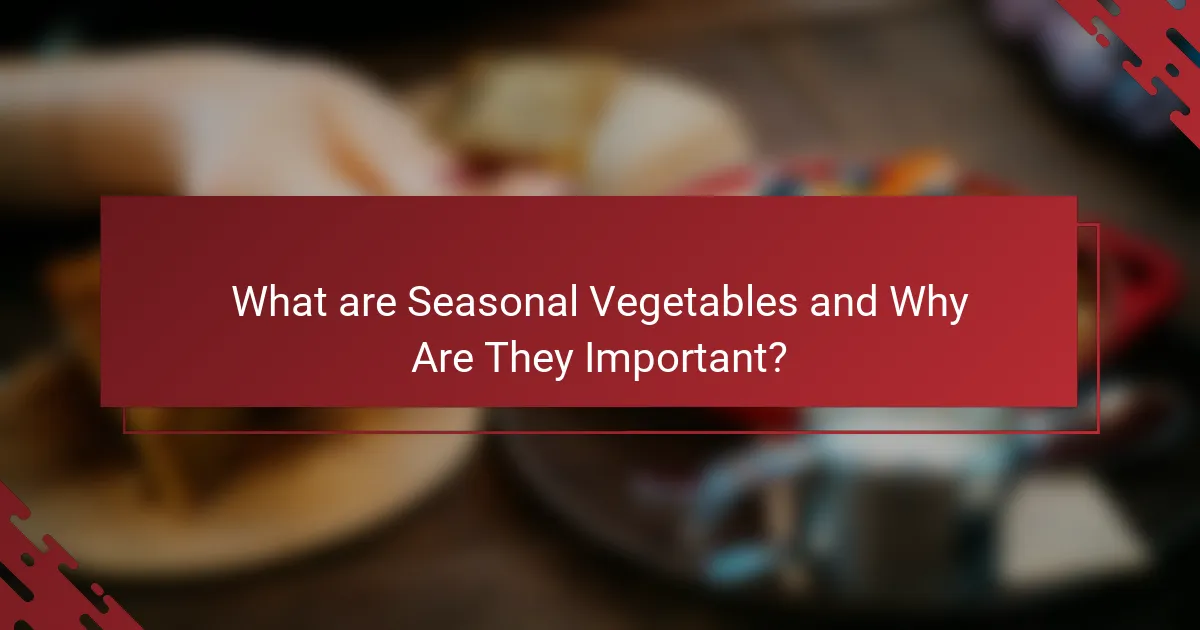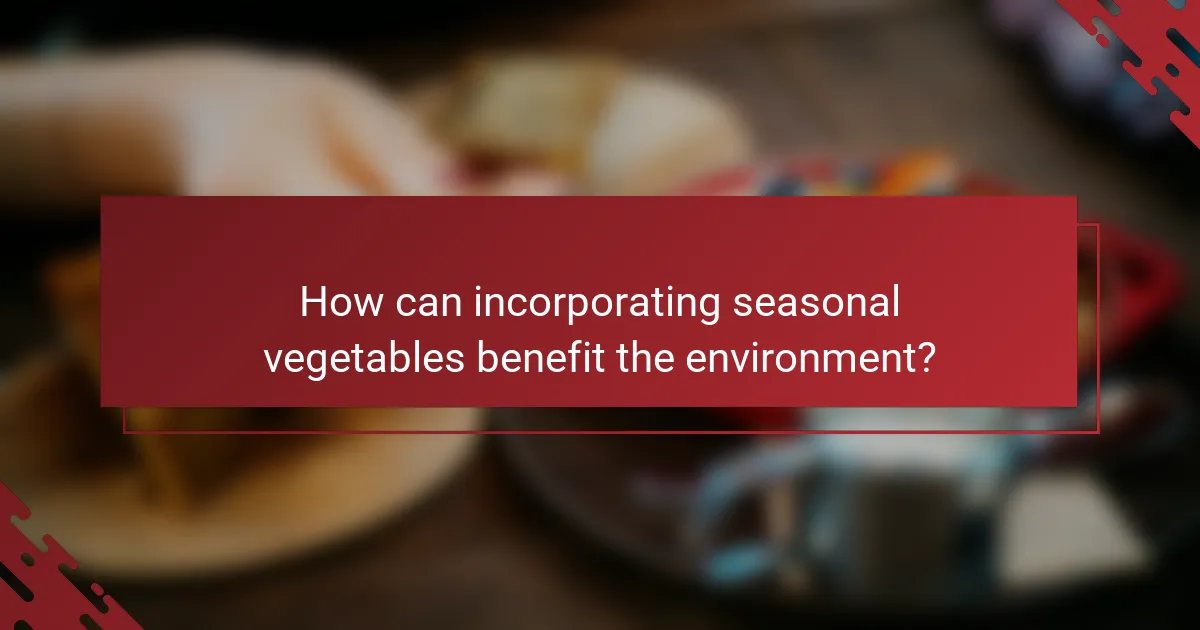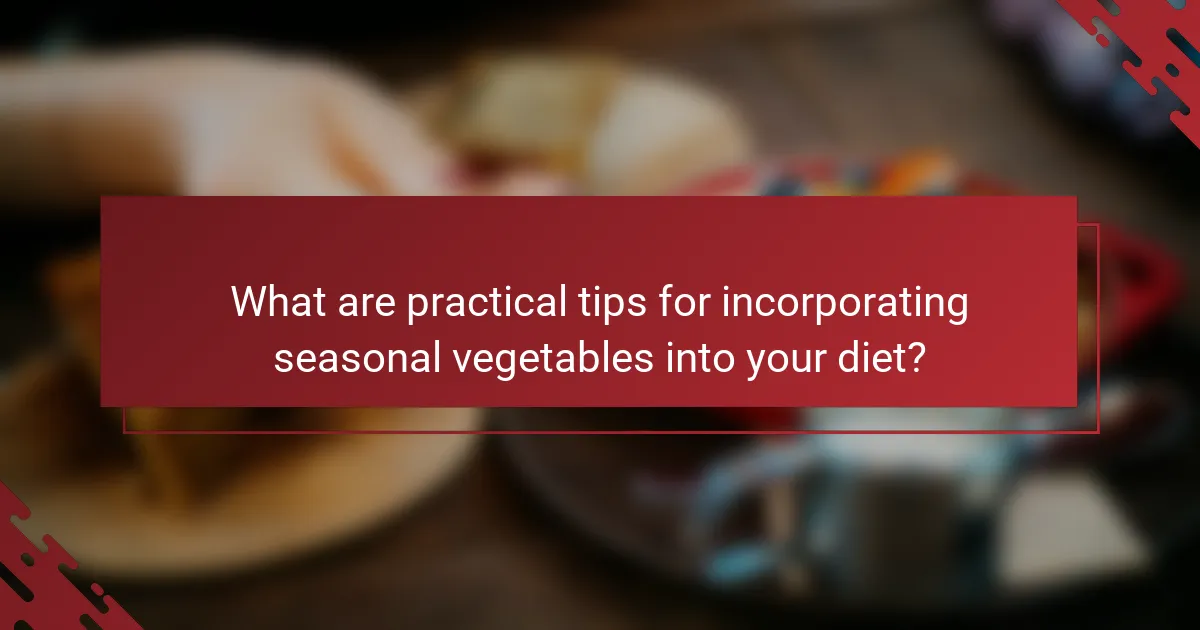Seasonal vegetables are plants harvested at specific times of the year, aligning with local climate and growing conditions. These vegetables offer enhanced taste, freshness, and nutritional value, often being more nutrient-dense than out-of-season alternatives. Consuming seasonal produce supports local farmers and economies, reduces environmental impact through lower transportation emissions, and can lead to cost savings. The article explores the benefits of incorporating seasonal vegetables into your diet, including their role in promoting dietary variety, enhancing health, and supporting sustainable agricultural practices. It also provides practical tips for sourcing and using seasonal vegetables effectively in meals.

What are Seasonal Vegetables and Why Are They Important?
Seasonal vegetables are plants that are harvested during specific times of the year. Their availability aligns with the local climate and growing conditions. Eating seasonal vegetables promotes better taste and freshness. They are often more nutrient-dense compared to out-of-season options. Seasonal produce typically has a lower environmental impact due to reduced transportation needs. This practice supports local farmers and economies. Studies show that consuming seasonal vegetables can enhance dietary variety and health. Seasonal eating can also lead to cost savings as these vegetables are often less expensive when in peak supply.
How do seasonal vegetables differ from non-seasonal ones?
Seasonal vegetables differ from non-seasonal ones primarily in their freshness and nutritional content. Seasonal vegetables are harvested at their peak ripeness, which enhances their flavor and nutrient density. They are often more affordable due to lower transportation costs and higher local availability. Non-seasonal vegetables may require longer storage and transportation times, leading to potential nutrient loss and reduced flavor. Studies show that seasonal produce contains higher levels of vitamins and antioxidants. For example, a 2016 study published in the Journal of Agricultural and Food Chemistry found that seasonal tomatoes had significantly higher vitamin C content than those grown out of season. This difference in nutritional value underscores the benefits of consuming seasonal vegetables.
What factors influence the seasonality of vegetables?
The seasonality of vegetables is influenced by climate, temperature, and growing conditions. Each vegetable has specific requirements for sunlight, moisture, and soil type. Seasonal changes affect these environmental factors, impacting growth cycles. For example, frost can limit the growth of tender vegetables, while heat can accelerate the maturation of others. Additionally, local agricultural practices and crop rotation can dictate when certain vegetables are available. Research indicates that vegetables grown in their optimal season have better flavor and nutritional value. Therefore, understanding these factors helps consumers choose the best seasonal vegetables for health and cooking.
How does the growing season affect the taste and texture of vegetables?
The growing season significantly influences the taste and texture of vegetables. Vegetables harvested at their peak during the growing season tend to have better flavor profiles. This is due to optimal sunlight, temperature, and moisture conditions that enhance natural sugars and flavors. For example, tomatoes grown in summer are sweeter and juicier than those grown in cooler months.
Texture is also affected by the growing season. Vegetables like carrots and beets develop a crisp texture when grown in the right season. Conversely, off-season vegetables may become woody or bland due to stress from environmental conditions. Research indicates that seasonal variations can lead to differences in nutrient content as well. Therefore, the growing season plays a crucial role in determining both the taste and texture of vegetables.
What nutritional benefits do seasonal vegetables offer?
Seasonal vegetables offer a range of nutritional benefits. They are often richer in vitamins and minerals due to being harvested at their peak ripeness. This peak period enhances their flavor and nutrient density. Seasonal vegetables also contain higher antioxidant levels, which help combat oxidative stress in the body. Eating seasonal produce can improve digestive health due to their fiber content. Additionally, they are typically fresher, leading to better taste and nutritional quality. Research indicates that consuming seasonal vegetables can support overall health and well-being.
Which vitamins and minerals are most abundant in seasonal vegetables?
Seasonal vegetables are rich in various vitamins and minerals. Commonly abundant vitamins include vitamin C, vitamin A, and several B vitamins. Minerals such as potassium, magnesium, and iron are also frequently found in these vegetables. For example, leafy greens like spinach provide high levels of vitamin K and folate. Root vegetables, such as carrots, are excellent sources of beta-carotene, a precursor to vitamin A. Seasonal vegetables often contain higher nutrient levels due to optimal growing conditions. Research indicates that fresh, in-season produce retains more vitamins compared to out-of-season counterparts.
How do seasonal vegetables contribute to a balanced diet?
Seasonal vegetables contribute to a balanced diet by providing essential nutrients and promoting variety. They are often fresher and more flavorful, enhancing meal enjoyment. Seasonal vegetables typically contain higher levels of vitamins and minerals due to optimal growing conditions. For example, vegetables such as tomatoes in summer are rich in lycopene, which supports heart health. Consuming seasonal produce can also improve digestive health due to their fiber content. Additionally, eating a diverse range of seasonal vegetables helps prevent nutrient deficiencies. Research indicates that diets rich in fruits and vegetables can lower the risk of chronic diseases. Therefore, incorporating seasonal vegetables is vital for maintaining overall health and well-being.
How does the availability of seasonal vegetables vary throughout the year?
The availability of seasonal vegetables changes throughout the year. Different vegetables thrive in specific seasons due to climate and growth cycles. For example, spring brings vegetables like asparagus and peas. Summer is abundant with tomatoes, cucumbers, and zucchini. Fall yields root vegetables such as carrots and squash. Winter typically sees the availability of hardy greens like kale and Brussels sprouts. This seasonal variation is influenced by factors like temperature, sunlight, and rainfall. Understanding these patterns helps consumers choose fresh, nutritious produce. Seasonal eating also supports local agriculture and reduces environmental impact.
What are the peak seasons for different types of vegetables?
The peak seasons for different types of vegetables vary based on climate and growing conditions. Generally, spring is ideal for leafy greens like spinach and lettuce. Summer is the peak season for tomatoes, cucumbers, and bell peppers. Fall brings the harvest of root vegetables such as carrots and beets. Winter is the season for hardy vegetables like kale and Brussels sprouts. These seasonal patterns are influenced by factors such as temperature and rainfall. Understanding these seasons helps consumers choose fresh, flavorful vegetables. Seasonal vegetables often have higher nutritional value and better taste.
How can consumers find seasonal vegetables in their area?
Consumers can find seasonal vegetables in their area by visiting local farmers’ markets. These markets typically feature produce that is in season. Another option is to check community-supported agriculture (CSA) programs. CSAs provide subscribers with seasonal produce directly from local farms. Additionally, consumers can explore online resources and apps that list seasonal produce by region. Websites like LocalHarvest.org help identify nearby farms and markets. Local gardening clubs may also offer information on seasonal vegetables. Finally, grocery stores often label seasonal items, making it easier for consumers to choose fresh produce.
What cooking techniques are best for preparing seasonal vegetables?
Roasting, steaming, and sautéing are the best cooking techniques for preparing seasonal vegetables. Roasting enhances natural sweetness through caramelization. It typically requires high heat and can be done with a variety of vegetables. Steaming preserves nutrients and color, making it a healthy option. This technique uses water vapor to cook vegetables without direct contact. Sautéing allows for quick cooking while retaining texture and flavor. It involves cooking vegetables in a small amount of oil over medium to high heat. Each technique highlights the unique flavors and textures of seasonal vegetables, ensuring a delicious outcome.
How can steaming enhance the nutritional value of seasonal vegetables?
Steaming enhances the nutritional value of seasonal vegetables by preserving vitamins and minerals. This cooking method uses moist heat, which reduces nutrient loss compared to boiling. Research indicates that steaming can retain up to 90% of vitamin C in vegetables. In contrast, boiling may lead to a loss of 50% or more of this vital nutrient. Steaming also helps maintain the vegetables’ natural colors and textures, making them more appealing. The quick cooking time limits exposure to heat, which further protects sensitive nutrients. Overall, steaming is an effective technique for maximizing the health benefits of seasonal vegetables.
What are some popular recipes that highlight seasonal vegetables?
Popular recipes that highlight seasonal vegetables include ratatouille, vegetable stir-fry, and roasted seasonal vegetable medley. Ratatouille features zucchini, eggplant, and bell peppers, showcasing summer harvests. Vegetable stir-fry can include broccoli, snap peas, and carrots, emphasizing spring and early summer vegetables. Roasted seasonal vegetable medley often combines root vegetables like carrots, potatoes, and beets, perfect for fall. These recipes utilize fresh, in-season produce, maximizing flavor and nutritional value. Seasonal vegetables provide essential vitamins and minerals, enhancing overall health.

How can incorporating seasonal vegetables benefit the environment?
Incorporating seasonal vegetables benefits the environment by reducing carbon emissions. Seasonal crops require less transportation, resulting in lower fossil fuel consumption. They are often grown using sustainable farming practices, which enhance soil health. This practice also supports local economies by promoting community agriculture. Furthermore, seasonal vegetables are typically more nutrient-dense, leading to healthier diets. Healthier populations can reduce healthcare costs and environmental strain. Research shows that local food systems can decrease greenhouse gas emissions by up to 25%. Thus, choosing seasonal vegetables is a practical step toward environmental sustainability.
Why is eating seasonal vegetables more sustainable?
Eating seasonal vegetables is more sustainable because they require fewer resources for production. Seasonal crops are grown during their natural growing period, which reduces the need for artificial heating, lighting, and extensive irrigation. This leads to lower energy consumption and reduced carbon emissions. Additionally, seasonal vegetables are often sourced locally, minimizing transportation distances. According to the USDA, local food systems can reduce greenhouse gas emissions by up to 25%. Furthermore, eating seasonal vegetables supports biodiversity by encouraging crop rotation and reducing monoculture practices. This approach helps maintain healthy ecosystems and soil quality.
How does seasonal eating reduce carbon footprints?
Seasonal eating reduces carbon footprints by minimizing transportation emissions. When consumers choose locally grown seasonal produce, they decrease the distance food travels. Shorter supply chains result in lower greenhouse gas emissions. Additionally, seasonal produce often requires less energy for storage and refrigeration. Studies show that food transported over long distances can generate significant carbon emissions. For example, transporting produce across the country can increase its carbon footprint by up to 10 times. By eating seasonally, individuals contribute to a reduction in overall environmental impact. This practice supports local economies and promotes sustainable farming methods.
What role do local farms play in the availability of seasonal vegetables?
Local farms significantly enhance the availability of seasonal vegetables. They cultivate crops that are specifically suited to the local climate and soil conditions. This localized approach ensures that vegetables are harvested at their peak freshness and nutritional value. Seasonal vegetables from local farms are often delivered to markets within hours of being picked. This reduces the time from farm to table, ensuring better flavor and quality. According to the USDA, local sourcing can also lead to a reduction in carbon footprint associated with transportation. Furthermore, local farms contribute to community food systems, promoting food security and sustainability. Their practices encourage biodiversity and preserve heirloom varieties that may not be available in larger commercial markets. Overall, local farms play a critical role in providing access to fresh, seasonal vegetables.
How can supporting local farmers impact seasonal vegetable consumption?
Supporting local farmers increases seasonal vegetable consumption by enhancing access and availability. When consumers buy directly from local farmers, they often receive fresher produce. This freshness retains more nutrients compared to vegetables transported long distances. Increased freshness encourages consumers to purchase and consume more seasonal vegetables.
Moreover, supporting local farmers fosters a community connection. This connection raises awareness about the benefits of eating seasonally. Education about seasonal availability can lead to increased demand for these vegetables. Studies show that local food systems can boost seasonal produce sales significantly.
For example, a report by the USDA indicates that local food sales reached $12 billion in 2014. This trend reflects growing consumer preference for fresh and seasonal options. Therefore, supporting local farmers directly influences seasonal vegetable consumption positively.

What are practical tips for incorporating seasonal vegetables into your diet?
Incorporating seasonal vegetables into your diet can enhance nutrition and flavor. Start by visiting local farmers’ markets for fresh, seasonal produce. Plan your meals around what is currently in season to ensure variety. Experiment with different cooking methods, such as roasting or steaming, to bring out the vegetables’ natural flavors. Join a community-supported agriculture (CSA) program to receive a regular supply of seasonal vegetables. Use seasonal vegetables in salads, soups, and stir-fries to increase their presence in your meals. Educate yourself on seasonal produce for your region to maximize your options throughout the year. Finally, preserve seasonal vegetables through freezing or canning for later use. These practices can help you enjoy the benefits of seasonal vegetables year-round.
How can meal planning help in using seasonal vegetables effectively?
Meal planning helps in using seasonal vegetables effectively by ensuring timely incorporation into meals. It allows individuals to align their grocery shopping with the seasonal availability of produce. This practice reduces waste by promoting the use of fresh ingredients before they spoil. Seasonal vegetables often have enhanced flavor and nutritional value. For example, tomatoes in summer are juicier and richer in vitamins. Meal planning can also encourage diverse cooking techniques that highlight seasonal produce. By planning meals around these vegetables, individuals can explore various recipes and cuisines. This approach fosters creativity in the kitchen and supports local farmers. Overall, meal planning maximizes the benefits of seasonal vegetables.
What are some easy ways to include seasonal vegetables in daily meals?
Incorporating seasonal vegetables into daily meals can be achieved easily through various methods. One effective way is to add them to salads. Fresh seasonal vegetables enhance flavor and nutrition. Another method is to include them in soups and stews. Cooking seasonal vegetables in these dishes maximizes their taste and health benefits. Stir-frying is also a quick option. This method retains the nutrients while offering a vibrant dish. Roasting seasonal vegetables brings out their natural sweetness. This technique is simple and requires minimal preparation. Additionally, blending seasonal vegetables into smoothies is a nutritious option. This way, you can enjoy their benefits in a convenient form. Lastly, using seasonal vegetables as toppings for pizzas or sandwiches adds variety. These approaches ensure that seasonal vegetables are a regular part of your diet.
What are common challenges when cooking with seasonal vegetables?
Common challenges when cooking with seasonal vegetables include availability, preparation time, and flavor variability. Seasonal vegetables may not always be readily available in certain regions or markets. This can limit options and require adjustments in meal planning. Preparation time can be significant, as many seasonal vegetables require washing, peeling, or cutting. Additionally, flavor can vary based on the season and growing conditions. This inconsistency may affect the overall taste of dishes. Cooking techniques may also need to be adapted based on the specific vegetable’s characteristics. Understanding these challenges helps in effectively incorporating seasonal vegetables into meals.
How can these challenges be overcome to maximize enjoyment and nutrition?
To overcome challenges and maximize enjoyment and nutrition from seasonal vegetables, individuals should prioritize meal planning. Meal planning allows for the incorporation of a variety of seasonal vegetables. This approach enhances nutritional intake and prevents food waste. Additionally, exploring diverse cooking techniques can elevate the flavors of these vegetables. Techniques such as roasting, steaming, or stir-frying can maintain nutrient levels while improving taste.
Research indicates that consuming seasonal produce can increase dietary diversity. A study published in the Journal of Nutrition found that individuals who eat a variety of fruits and vegetables have better overall health outcomes. Furthermore, participating in local farmers’ markets can provide access to fresh, seasonal options. This not only supports local agriculture but also encourages the consumption of nutrient-rich foods. Engaging in community-supported agriculture (CSA) programs can also help individuals receive a regular supply of seasonal vegetables.
The main entity of this article is seasonal vegetables, which are plants harvested during specific times of the year, offering better taste, freshness, and nutritional value. The article explores the importance of seasonal vegetables, highlighting their nutritional benefits, factors influencing their seasonality, and how the growing season affects their taste and texture. It also discusses practical tips for incorporating seasonal vegetables into diets, cooking techniques that enhance their flavors, and the environmental benefits of consuming locally sourced produce. Additionally, the article addresses common challenges in cooking with seasonal vegetables and provides strategies to overcome these obstacles for improved enjoyment and nutrition.